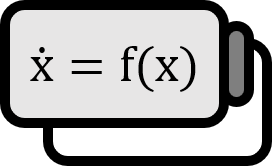Hysteresis Phenomena in Dynamics
Definition
The phenomenon where changes in a dynamical system due to parameter variations are irreversible is called hysteresis1.
Explanation

As an example, consider the fold bifurcation shown above. For simplicity, let’s imagine $x$ represents the population of bees, and $r$ represents the average temperature. The bifurcation diagram reveals that the system can have up to three fixed points, with two of them being stable fixed points, meaning the bee population will converge to one of these two points.
Crisis

Imagine the bee population is initially at a relatively high level, $x_{2}$, and due to global warming, the temperature $r = r(t)$ gradually increases. Initially, the value of the stable fixed point $x_{2} = x_{2} (r)$ decreases slowly, but after passing the turning point $r_{2}$, $x_{2}$ disappears and the population converges to $x_{1}$, leading to a sudden collapse. This abrupt or catastrophic change in certain values is referred to as a crisis or catastrophe.
Recovery

Conversely, after experiencing a crisis, if $r$ decreases and passes the turning point $r_{2}$ again, the system cannot immediately return to its original state. The population is already near the relatively lower $x_{1}$—in other words, the population $x(t)$ already belongs to the basin of $\left\{ x_{1} \right\}$—and unless there’s an extreme change passing through the turning point $r_{1}$, it remains at the lower population level $x_{1}$. In this sense, we discover an irreversibility in the system associated with the direction of $r$’s movement around the turning points, and this is what is referred to as hysteresis.
Strogatz. (2015). Nonlinear Dynamics And Chaos: With Applications To Physics, Biology, Chemistry, And Engineering(2nd Edition): p60. ↩︎
